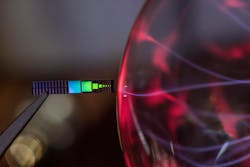Solid-State Silicon Device Turns Waste Heat into Electricity
Researchers from Sandia National Laboratories have developed a silicon-based device that converts waste heat into DC power. The device consists of common and abundant materials, such as aluminum, silicon, and silicon dioxide. It is also small, about 1/8 in. by 1/8 in., and half as thick as a dime. The top is aluminum etched with stripes roughly 20 times smaller than the width of a human hair. This pattern, though far too small to be seen by eye, serves as an antenna to catch infrared radiation.
Between the aluminum top and the silicon bottom is a layer of silicon dioxide about 20 silicon atoms thick. The patterned and etched aluminum antenna channels the IR radiation into this thin layer. The IR radiation trapped in the silicon dioxide creates fast electrical oscillations—about 50 trillion cycles per second. This pushes electrons back and forth between the aluminum and silicon in an asymmetric manner. This process, called rectification, generates net DC electrical current.
The team calls its device an infrared rectenna. It is a solid-state device with no moving parts to jam, bend, or break. Better still, it doesn’t have to directly touch the heat source, which can cause thermal stress.
Because the team makes the infrared rectenna with the same processes used by the integrated circuit industry, it’s readily scalable, says Joshua Shank, an electrical engineer who tested the devices and modeled the underlying physics while he was a Sandia postdoctoral fellow. He notes that the team deliberately focused on common materials and processes that are scalable. So, in theory, any commercial integrated circuit fabrication facility could make rectennas.
That isn’t to say fabricating the device was easy. One of the biggest fabrication challenges was inserting small amounts of other elements into the silicon, or doping it, so that it would reflect infrared light like a metal. The devices were made at Sandia’s Microsystems Engineering, Science, and Applications Complex. The team has been issued a patent for the infrared rectenna and has filed several additional patents.
The first version of the infrared rectenna produces 8 nW of power per square centimeter from a specialized heat lamp at 840 C. For comparison, a typical solar-powered calculator uses about 5 mW, so it would take a sheet of rectennas slightly larger than a standard piece of paper to power a calculator.
The team has several ideas for improving its rectenna. One is to make the device’s top pattern two-dimensional x’s instead of one-dimensional stripes so they absorb IR light over all polarizations. The team also plans on redesigning the rectifying layer to be a full-wave rectifier instead of the current half-wave rectifier. To minimize power losses due to resistance, it intends on making the rectenna on a thinner silicon wafer.
In the short term, the team’s goal is to make compact infrared power supply to perhaps replace radioisotope thermoelectric generators (RTGs). RTGs power sensors on spacecraft that don’t get enough direct sunlight to power solar panels. The team believes it can accomplish this goal within five years.
“We need to continue to improve to be comparable to RTGs, but the rectennas will be useful for any application where you need something to work reliably for a long time and where you can’t go in and just change the battery,” says Shank. “However, we’re not going to be an alternative for solar panels as a source of grid-scale power, at least not in the near term.”

